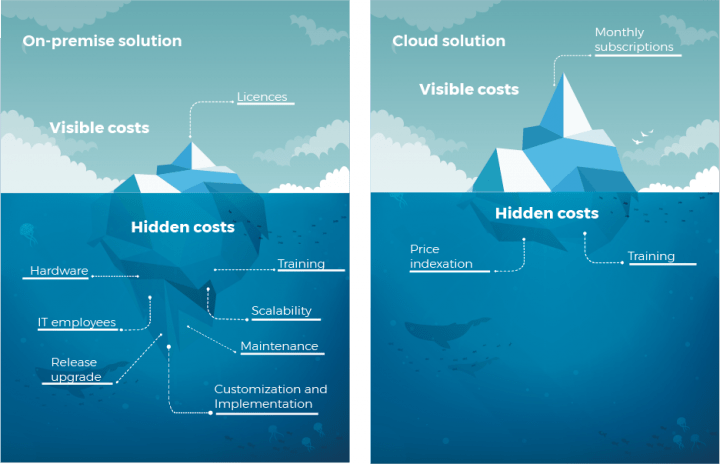Intro
Every IT Director or Supply Chain Manager has at least once faced this problem: to demonstrate the success of an IT project. The most common indicator used to estimate and present the success of a project is the ROI (return on investment). In short it means that you compare the cost of your investment with the estimated revenues. This ratio is largely used but do not take into account the intangible aspect of your solution on the business, for example the level of stress or collaboration among employees.
If you wish to consider the financial (tangible) impact AND the intangible value of a solution, the ROV (return on value) should be a more accurate ratio for you. This indicator considers the quantitative indicators (financial investment, costs, time, level of stocks…) but also the qualitative ones (communication among the team, stress level of employees…) in the value calculation. This way, the ROV can apply to solutions that do not require financial investment such as SaaS solutions, that have low cost of entry.
Whether you wish to calculate the ROI or ROV, there are two mains elements to consider before anything else: the cost of the solution and the business model of the implemented solution. Then a quantitative and qualitative analysis of different KPIs will complete the calculation.
The price of a solution (on-premise or cloud)
Whether you want to get a ROV or ROI, the first obvious steps is to identify the costs associated to the project. When looking for the costs it is important to look for the “transparent costs” (for example the licences or monthly subscriptions) as well as the “hidden costs” that derive from the usage of the solution in time and are most of the time forgotten.
These costs will depend on the project and type of solution. An on-premise solution will entail more hidden costs than a Cloud solution that will need less or no technical installation(among other things)
Hidden and visible costs, the iceberg theory

Explanations:
Hardware: purchasing of personal servers, SQL licences, associated components…
IT employees: To support an on-premise solution, it is necessary to have employees that will specifically work on the support of this solution: administrator, installation on users’ PC, database experts, IT employees…
Scalability: An on-premise tool will unlikely include automatic scalability or free release upgrade in the initial cost because of the significant customization of the solution.
If your activity, and associated volumetry, go through a sudden growth (acquisition of a new market…), it will be more difficult to change the current architecture with an on-premise solution. Indeed, an increase of your server power will mean an interruption of services, non-regression testing of the installed material, a mitigation and shift procedure… With the agility of the cloud, scalability (power adaptation according to your needs) is quick and easy and without smoke screen for the users (only a minute of interruption).
Customization and implementation: Customization and implementation time is usually longer for on-premise solutions. For a Cloud solution with few customization, we are talking about configuration more than implementation which mean shorter project.
Training: When you decide to implement a new solution within your company, whether it’s a cloud or on-premise solution you will need to take into account the cost of training your teams (time spent, training sessions…). Some tools exist to reduce that training time such as Colibri: training costs are moderated and included in a package, which decrease the risk of going overbudget.
Release upgrade: When an on-premise solution become outdated, the latest version available will unlikely fit your business because of the customization of your previous version. To get the latest version, you will need to start a new project with non-regression or to switch solution. There is also a risk that you will need to pay for new licences.
With cloud solutions, such as Colibri, clients are assured to get the latest available version at all time (the same goes for release upgrades) without additional costs for the clients.
Maintenance: For cloud solutions, maintenance and corrective applications are shared for all the clients. So, when a bug is reported, it will be corrected and expanded to all. For on-premise applications, it is not that simple as each client has a specific solution. Moreover, for on-premise solution, corrections usually need to be set up by an IT team, following a procedure, generating a service intervention…
Price indexation: for cloud solution, prices can usually be reviewed each year. Therefore, there is a risk to see your subscription increase. To give visibility, cloud editors include most of the time a clause in the contract to control the price (the price will follow the Syntec index for example). It is also important to mention that cloud editors focus on fidelity, so logically they will not be inclined to drastically increase their prices.
To evaluate the total costs of a project it is important to take the time to consider the direct and indirect costs of a project, but, it is not the only parameter to focus on.
The Business Model
In addition to the costs, understanding the business model of your solution is also important when calculating your ROI or ROV.
When choosing a cloud solution, the starting investment is low or nonexistent, but, you will need to pay a subscription on an ongoing basis. On the other hand, for an on-premise solution, the cost of entry will be way higher, increasing the risk if the solution does not fit the needs. There are no subscriptions fees per se but usually an annual maintenance fee representing a percentage of the acquired licences (in general 20%).
The added value of a certain business model
The fact to have a certain business model can also be a source of value for your business.
For example, a SME with a small investment capacity and a rapid growth will probably prefer a cloud solution, a more affordable and scalable alternative, against an on-premise solution with a higher investment cost and less scalability over time. The value that result from choosing a type of business model must be taken into account when calculating the ROV.
Associated risks
The chosen business model is also associated to risks that also need to be part of the ROV calculation.
An on-premise solution (because of the customization opportunity and complexity) will take longer to implement than a cloud solution (without customization or technical installation). An on-premise solution will take from 6 months to 1 year to be implemented, for a cloud solution this delay is reduced to 2 to 4 months.
Moreover, the licences business model with longer project time create a risk of tunnel effect for these solutions. If the company situation evolves during the project the solution might not answer the needs of the users. In addition, licences being quite expensive, changing solution will not be as easy as it is with a cloud solution. SaaS editors can also ask for a commitment period (of 1 to 3 years) which is also a metric to consider when calculating the risks and ROV.
The Client/Editor relation
The business model can also be an indicator on how the relation client/editor will be. A SaaS solution will need to hold on to its customers that will renew their subscription every year or so. Editors must listen to their customers and improve regularly the solution to keep a high satisfaction rate. The SaaS model offer a relationship closer to the partnership than the client/supplier one. On the contrary, on-premise solution will move the power balance to the editor side as he will receive most of its revenue at the contract signature or beginning of the project.
Conclusion :
To calculate the ROI or ROV of a new IT project, the first step will logically be to get a precise idea of the costs, considering equally the visible and intangible costs. A business model study of the chosen solution will then allow to analyze the positive or negative value resulting from the project.
The next step will be to analyze KPIs to establish the quantitative and qualitative outcomes of the projects.






